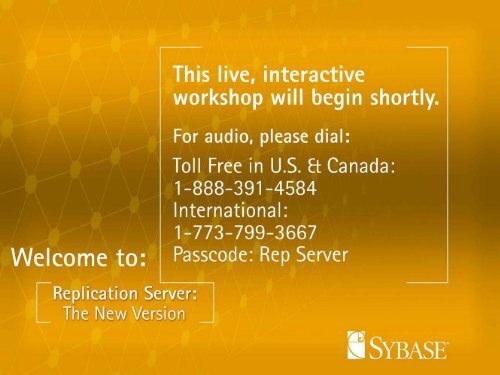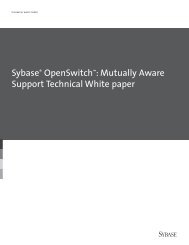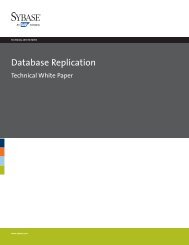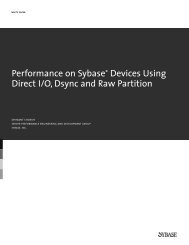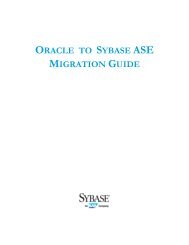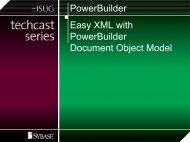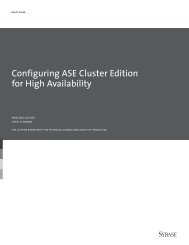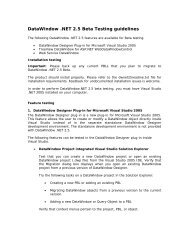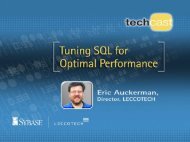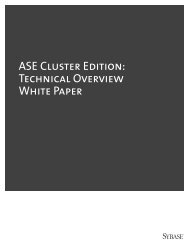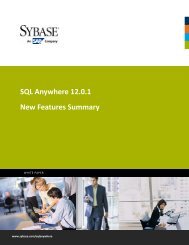Replication Server Presentation - Sybase
Replication Server Presentation - Sybase
Replication Server Presentation - Sybase
Create successful ePaper yourself
Turn your PDF publications into a flip-book with our unique Google optimized e-Paper software.
Why Replicate<br />
• High Availability of data<br />
• Planned, Unplanned downtime and Disaster Recovery<br />
• Data Distribution<br />
• Decentralizations<br />
• Consolidations<br />
• Load balancing<br />
• Live decision support<br />
• Separation of OLTP and DSS
<strong>Replication</strong> and High Availability<br />
Philadelphia Operations<br />
ASE<br />
PRIMARY DATACENTER<br />
Denver Operations<br />
ASE<br />
<strong>Replication</strong><br />
<strong>Server</strong><br />
<strong>Replication</strong><br />
<strong>Server</strong><br />
SECONDARY DATACENTER<br />
Warm Standby<br />
•Minimize/eliminate user impact<br />
•Protect against unplanned<br />
outages<br />
•Software, Hardware,<br />
Application failure<br />
•Unforeseen circumstances like<br />
data corruption<br />
•Protect against planned outages<br />
•Software, Hardware,<br />
Application upgrades<br />
•Enable ops to perform<br />
maintenance activities<br />
•Recover from natural disaster<br />
•Without geographic restrictions
<strong>Replication</strong> System Architecture: Warm Standby<br />
Active DB<br />
Add’l routes/<br />
connections<br />
Logical DB<br />
Standby DB<br />
RS<br />
• Special Configuration: One Active,<br />
One Standby Database managed by<br />
One Rep <strong>Server</strong><br />
• May be configured to replicate the<br />
entire database – Complete Mirror!<br />
(publish-subscribe mechanism not<br />
required)<br />
• DDL/Schema Change replication!<br />
• Direction of <strong>Replication</strong> can be<br />
switched<br />
• Performs failover and failback<br />
• Ease of Administration, Low latency<br />
• Active-Standby pair viewed as a<br />
single logical DB at other replicate<br />
sites
<strong>Replication</strong> and Data Distribution<br />
• Continuous Secure<br />
<strong>Replication</strong> of<br />
changed data<br />
CRM-sales, customer<br />
Financial Information<br />
Dealers<br />
Dealers<br />
• Guaranteed<br />
Delivery<br />
ASE<br />
Rep <strong>Server</strong><br />
ASE<br />
Rep <strong>Server</strong><br />
For<br />
• Decentralization<br />
• Consolidation<br />
• Load Balancing<br />
ASE<br />
Rep <strong>Server</strong><br />
New York Consolidation<br />
ASE<br />
Rep <strong>Server</strong><br />
ASE<br />
Rep <strong>Server</strong>
<strong>Replication</strong> and Live Decision Support<br />
• Separate Operational data from Decision Support<br />
• Run intensive queries without effecting the<br />
performance of transaction processing system<br />
• Real-time alternative to Data Warehousing<br />
OLTP<br />
DSS<br />
ASE Rep <strong>Server</strong> Rep <strong>Server</strong> ASE
Requirements for e-Business Data Movement<br />
• Increasing demand for assurance of privacy<br />
• Solution: Secure, guaranteed replication for data<br />
distribution<br />
• Flexibility in moving data around the enterprise<br />
• Solution: Support replication of e-business data across<br />
heterogeneous databases<br />
• 24/7 system availability<br />
• Solution: High Performance Data <strong>Replication</strong> through<br />
<strong>Replication</strong> <strong>Server</strong> Warm Standby
<strong>Replication</strong> <strong>Server</strong> 12.5: New Features<br />
New Features<br />
• Security<br />
• Advanced Security Option – SSL Support<br />
• Flexibility<br />
• Unicode Support<br />
• LDAP Support<br />
• Extended Limits Data Support<br />
• Multi-Vendor <strong>Replication</strong><br />
• Performance<br />
• Configurable Transaction Partitioning for Parallel DSI<br />
• SMP Support<br />
• Commit Sequencing Enhancements for Parallel DSI
Security - SSL Support<br />
Background<br />
• SSL – Secure Socket Layer – is an industry standard for<br />
sending socket-level encrypted data over network<br />
connections<br />
• Different Encryption algorithms can be used for data<br />
security<br />
• Data integrity is guaranteed through Digital Signatures for<br />
tamper protection and non-repudiation<br />
• Mutual authentication of servers and clients through Digital<br />
Certificates<br />
• Typically for communications over a wide area network<br />
• The computing overhead of encryption limits its use in LAN<br />
environments behind the firewall
Security - Advanced Security Option – SSL<br />
• <strong>Replication</strong> <strong>Server</strong> provides advanced security for data<br />
communications through SSL Support<br />
• All data exchanges with other servers (ASE or RS) can<br />
use SSL for data encryption<br />
• SSL can be used selectively on specific connections or<br />
routes<br />
• SSL Support is a separately license-able option<br />
Route<br />
DSI<br />
RepAgent<br />
RS<br />
SSL SSL SSL
Security - SSL Support<br />
• <strong>Replication</strong> <strong>Server</strong> can act as a client and a server for<br />
SSL communication<br />
• Acts as a client when connecting to ASE (DSI<br />
connections) or to other <strong>Replication</strong> <strong>Server</strong>s (routes)<br />
• Acts as a server when accepting connections from<br />
<strong>Replication</strong> Agent or from other <strong>Replication</strong> <strong>Server</strong>s<br />
(routes)<br />
• A configuration parameter determines whether<br />
<strong>Replication</strong> <strong>Server</strong> can accept SSL connections<br />
• The parameter determines its behavior as a server, not<br />
as a client<br />
• configure replication server set use_ssl to {on | off}
Security - SSL Support<br />
• The interfaces file entry indicates to the client that the<br />
server requires SSL connections<br />
• If the target (ASE or RS) requires SSL communication<br />
(through the interface entries), the client automatically<br />
uses SSL to connect<br />
• Different clients can use or not use SSL to connect to the<br />
same server using different interface files<br />
• SSL incurs considerable overhead at connection setup<br />
WAN/Internet<br />
SSL<br />
SSL<br />
London RS<br />
Route<br />
Interface file with SSL Entry<br />
for NYRS<br />
NYRS<br />
NJRS<br />
Interface file with plain<br />
Entry for NYRS
Security - SSL Support<br />
Prevent interception of sensitive information<br />
• SSL Encryption protects from both accidental<br />
disclosure as well as wire taps<br />
• PKI-certificates authenticate servers to clients<br />
• Fully embedded in product, reducing complexity to<br />
client applications<br />
• Complete end-to-end security services support for ASE<br />
replication environment
Flexibility - Unicode Support<br />
• <strong>Replication</strong> <strong>Server</strong> 12.5 supports utf8 character set as<br />
a default character set for the server<br />
• Greatly benefits global environments with multiple<br />
languages and character sets<br />
• By running all <strong>Replication</strong> <strong>Server</strong>s in the environment<br />
with utf8 character set, you minimize data conversions<br />
and thereby, minimize data loss<br />
Japan<br />
operations<br />
ASE RS ASE RS<br />
No data conversion, no data loss<br />
German<br />
operations<br />
ASE RS<br />
New York Consolidation
Flexibility - Unicode Support<br />
• Supports replication of Unicode data (UCS-2)<br />
• Supports replication of two new ASE 12.5 data types: unichar,<br />
univarchar<br />
• Unichar is a fixed-width non-nullable data type<br />
• Univarchar is a variable width, nullable data type<br />
• Both use UTF-16, a fixed two-byte encoding of Unicode<br />
• Support includes:<br />
• <strong>Replication</strong> to Standby databases<br />
• <strong>Replication</strong> to Replicate databases<br />
• Data types can be included in replication definitions<br />
• As searchable columns (subscriptions can use them in<br />
where clauses)
Flexibility - Unicode Support<br />
• <strong>Replication</strong> of Unicode data<br />
• Different sort order used for Unicode data (unichar,<br />
univarchar columns), defined by the new<br />
RS_unicode_sortorder parameter in the configuration file<br />
(default: binary)<br />
• RS_subcmp supports the unicode data types<br />
• Mixed Version Support<br />
• <strong>Replication</strong> Definition that includes unicode data types is<br />
not propagated to pre-12.5 servers (dropped from pre-<br />
12.5 servers if it already exists)<br />
• <strong>Replication</strong> Definition that is subscribed by pre-12.5<br />
servers can not be altered to include unicode data types
Flexibility - LDAP Support<br />
• Allows <strong>Replication</strong> <strong>Server</strong> to retrieve <strong>Server</strong> connection<br />
information from an LDAP server<br />
• Ease of administration in distributed, enterprise-wide<br />
environments with heterogeneous platforms<br />
• A standard, central way<br />
of managing directory<br />
information can<br />
be supported in<br />
replication<br />
environments<br />
LDAP Directory<br />
ASE RS ASE RS<br />
ASE<br />
RS
Flexibility - Extended Limits Data Support<br />
• Complete support for replication of extended limits data<br />
– wide columns, wide tables, wide stored procedures<br />
etc.<br />
• Column widths up to 32K bytes<br />
• Tables up to 1024 columns<br />
• Stored Procedures up to 1024 parameters<br />
• Internal limitation of replication message length of 16K<br />
bytes eliminated<br />
• Support for larger page sizes in ASE (2K, 4K, 8K or 16K)
Flexibility - Extended Limits Data Support<br />
• <strong>Replication</strong> Definition can include<br />
• Wider columns (up to 32K bytes) and up to 1024 cols<br />
• Can be marked as primary columns or searchable cols<br />
• No limit (up to 1024) on the number of columns in<br />
primary key or searchable list<br />
• Only propagated to 12.5 sites if new limits are used<br />
• Before 12.5, <strong>Replication</strong> Message length (length of<br />
each message passed between ASE-RS and RS-RS)<br />
had to be below 16K bytes (fit within a Stable Queue<br />
block)<br />
• Starting with 12.5, replication messages can span<br />
multiple blocks<br />
• <strong>Replication</strong> of wider column data is likely to result in<br />
wider replication messages
Flexibility - Extended Limits Data Support<br />
Mixed Version Support<br />
• ASE <strong>Replication</strong> Agent will detect if the <strong>Replication</strong><br />
<strong>Server</strong> can handle wide data<br />
• If not, <strong>Replication</strong> Agent will truncate or skip the data (as<br />
configured) before sending it over to <strong>Replication</strong> <strong>Server</strong><br />
• “Route Version” will determine if wide data can be<br />
handled by <strong>Replication</strong> <strong>Server</strong>s at either end of the<br />
route<br />
• <strong>Replication</strong> <strong>Server</strong> will skip over any messages that are<br />
larger than the 16K limit before sending data over to<br />
other <strong>Replication</strong> <strong>Server</strong>s that can’t handle wide data<br />
• <strong>Replication</strong> Definitions that contain wide columns are not<br />
propagated to sites that can’t handle wide data, hence<br />
replication to older sites is limited to older limits
Flexibility - Extended Limits Data Support<br />
Migration<br />
• <strong>Replication</strong> <strong>Server</strong> can be used in conjunction with the<br />
ASE Migration Tool to migrate between databases of<br />
different page sizes over a period of time<br />
• Migration Tool can be used to setup the secondary<br />
copy, while <strong>Replication</strong> <strong>Server</strong> can keep the copies in<br />
synch, such that migration occurs over a period of time<br />
and applications can be fully tested<br />
• The same technique (with dump/load) can be used to<br />
migrate from one server version to another (or a<br />
combination of version and page size change) with<br />
almost no downtime
Flexibility - Multi-Vendor <strong>Replication</strong><br />
Primary DB<br />
(Oracle)<br />
RS<br />
Add’l routes/<br />
connections<br />
Rep Agent<br />
for Oracle<br />
• <strong>Replication</strong> Agents pull data<br />
out of non-<strong>Sybase</strong> sources<br />
• DirectConnects are used as<br />
gateways to replicate into<br />
non-<strong>Sybase</strong> targets<br />
• Support for vendor-specific<br />
datatypes, translations etc.<br />
Replicate DB<br />
(MS SQL)<br />
DirectConnect<br />
for MS SQL<br />
• Some <strong>Replication</strong> Agents<br />
read the transaction log<br />
(DB2), some build a virtual<br />
log with triggers (Oracle,<br />
MS SQL)
Flexibility - Heterogeneous <strong>Replication</strong><br />
• Extended Limits Data<br />
• Wide data (columns, tables and stored procedures) can<br />
be replicated between multi-vendor databases – ASE,<br />
Oracle, DB2 etc.<br />
• <strong>Replication</strong> Agent, DirectConnect supports replication of<br />
wide data<br />
• LOB (Text/Image) Data<br />
• <strong>Replication</strong> Agent now supports LOB replication out of<br />
DB2 UDB<br />
• LOB support by Direct Connect for Oracle allows end-toend<br />
replication of text/image data for Oracle<br />
environments
Flexibility - Heterogeneous <strong>Replication</strong><br />
• Unicode<br />
• Unicode data can be replicated between multi-vendor<br />
databases<br />
• <strong>Replication</strong> Agent and Direct Connect for Oracle support<br />
replication of unicode data and UTF-8 character set<br />
• Platform Support<br />
• Oracle 8.1.7 and 9i (<strong>Replication</strong> Agent, Direct Connect)<br />
• IBM DB2 UDB 6.1, 7.1 and 7.2 (RA, DC)<br />
• SQL <strong>Server</strong> 7.0 and 2000 (aka 8.0) (RA, DC):<br />
<strong>Replication</strong> Agent is now available on Unix and Windows<br />
2000<br />
• Informix 7.3 and 9.2 (RA, DC)
<strong>Replication</strong> <strong>Server</strong> Packaging<br />
<strong>Replication</strong><br />
<strong>Server</strong><br />
Base<br />
Package<br />
<strong>Replication</strong> <strong>Server</strong> Base <strong>Server</strong> License<br />
<strong>Replication</strong> <strong>Server</strong> Manager<br />
<strong>Sybase</strong> Central Plug-in for<br />
<strong>Replication</strong> <strong>Server</strong><br />
<strong>Replication</strong> <strong>Server</strong> - Advanced Security Option<br />
Option for<br />
Oracle<br />
Option for<br />
Informix<br />
Option for<br />
Microsoft<br />
Option for<br />
DB2/UDB<br />
RA<br />
RA<br />
RA<br />
RA<br />
<strong>Replication</strong><br />
<strong>Server</strong><br />
Options<br />
Package<br />
DC<br />
DC<br />
DC<br />
DC<br />
ASE<br />
ASE<br />
ASE<br />
ASE
<strong>Replication</strong> <strong>Server</strong> 12.5<br />
Performance Enhancements<br />
• Configurable Transaction Partitioning for Parallel DSI<br />
• SMP Support – Will be released in an EBF 3-4 months<br />
• Commit Sequencing Enhancements for Parallel DSI –<br />
Will be released in an EBF 3-4 months
Performance Enhancements<br />
Configurable Transaction Partitioning<br />
Background<br />
• Parallel DSI threads in RS attempt to apply transactions in<br />
the queue to the replicate DB in parallel<br />
• Each DSI thread opens a connection to the replicate DB<br />
• Commit order is still maintained – only the “body” of the<br />
transactions are applied in parallel<br />
• Transactions can also be grouped together to apply “more”<br />
in each unit of work – grouping rules decide which<br />
transactions can be grouped<br />
• Not all transaction “bodies” can be applied in parallel<br />
• Some of them may deal with the same tables/rows<br />
• Resulting in deadlocks and rollbacks, reducing<br />
throughput<br />
• Transaction grouping increases the chance of contention
Performance Enhancements<br />
Configurable Transaction Partitioning<br />
• Traditional Transaction Partitioning<br />
• The transactions (transaction groups) are partitioned<br />
across DSI threads in a round robin fashion<br />
Queue<br />
T3<br />
T2<br />
T1<br />
T1<br />
T2<br />
T3<br />
• Possibility of deadlocks or contention if transactions<br />
(groups) assigned to different threads work on the same<br />
tables or rows<br />
• Both transactions are rolled back and applied serially if a<br />
deadlock is detected
Performance Enhancements<br />
Configurable Transaction Partitioning<br />
• Configurable Transaction Partitioning<br />
• The transactions are grouped and partitioned across DSI<br />
threads intelligently based on transaction attributes<br />
(configurable)<br />
• The goal is to reduce contention by recognizing which<br />
transactions can be applied in parallel and which<br />
transactions can be grouped<br />
• Transaction commit time, Transaction name and User<br />
name are used to determine how transactions can be<br />
partitioned<br />
Queue<br />
T3<br />
T2<br />
T1<br />
T1, T2<br />
T4, T5<br />
T3<br />
Tran Partitioning Rules Engine
Performance Enhancements<br />
Configurable Transaction Partitioning<br />
• Username Based Transaction Partitioning<br />
• Transactions owned by the same user are forced to execute<br />
serially (possibly in the same transaction group) since they<br />
were probably executed one after the other at the primary by<br />
the same user<br />
• Transaction Name Based Transaction Partitioning<br />
• Transactions with the same name are forced to execute<br />
serially (possibly in the same transaction group) since they<br />
probably represent operations on related data and might lead<br />
to contention if attempted in parallel<br />
• Commit Time based Transaction Partitioning<br />
• Transactions that have overlapping execution times are<br />
assigned to (different groups and) parallel threads since they<br />
were applied concurrently at the primary – less chance for<br />
contention
Performance Enhancements<br />
Configurable Transaction Partitioning<br />
• <strong>Replication</strong> <strong>Server</strong> attempts to mimic users at primary<br />
DB<br />
• Brings replicate throughput closer to primary DB<br />
throughput<br />
• Reduces contention among multiple RS threads (DSI)<br />
applying transactions at the replicate DB<br />
• Optimal resource utilization by minimizing deadlocks and<br />
rollbacks<br />
• Parallel DSI Processing is made more efficient by<br />
reducing the contention and deadlocks in the replicate<br />
DB
Performance Enhancements<br />
SMP Support<br />
• Takes advantage of SMP architecture and improves<br />
scalability<br />
• Parallelizing internal <strong>Replication</strong> <strong>Server</strong> processing<br />
decreases latency and increases throughput<br />
• Scales well for replication of multiple sources and<br />
targets within the same server
Performance Enhancements<br />
SMP Support<br />
• <strong>Replication</strong> <strong>Server</strong> will utilize multiple processors on the<br />
machine<br />
• Built on SMP Open <strong>Server</strong><br />
• Based on a threading model rather than an engine model<br />
• Uses OS Native threads in pre-emptive mode<br />
• <strong>Server</strong> spawns numerous cooperating threads that run<br />
concurrently<br />
• Number of CPUs used by the server can be controlled by<br />
binding the CPUs to the server using OS-specific<br />
mechanisms<br />
• e.g., psrset/pbind on Solaris<br />
• <strong>Server</strong> can be forced into a single processor mode using<br />
a switch<br />
• configure replication server set smp_enable to {on | off}
Performance Enhancements<br />
Commit Sequencing Enhancements<br />
Background<br />
• Parallel DSI threads in RS attempt to apply<br />
transactions in the queue to the replicate DB in parallel<br />
• Commit order is still maintained – only the “body” of the<br />
transactions are applied in parallel<br />
• <strong>Replication</strong> <strong>Server</strong> relies on a table in the replicate DB<br />
(rs_threads) to detect deadlocks and help sequence<br />
commits<br />
• Additional overhead on the replicate DB<br />
• Additional network roundtrips (between RS and replicate<br />
DB) for each transaction (group)<br />
• Limits the usability of Parallel DSI to ASE environments
Performance Enhancements<br />
Commit Sequencing Enhancements<br />
Internal Commit Sequencing<br />
• Deadlock detection for transactions distributed across<br />
Parallel DSI threads is now done internally in<br />
<strong>Replication</strong> <strong>Server</strong><br />
• Commit sequencing is now completely internal to RS<br />
• Eliminates a network roundtrip for each transaction –<br />
reduced I/O<br />
• Less overhead for each transaction (group) – faster<br />
commit processing<br />
• Removes the reliance on replicate DB<br />
• Eliminates a bottleneck (rs_threads) in the replicate DB<br />
• Allows non-ASE environments to take advantage of the<br />
Parallel DSI feature
Summary<br />
• The e-Business data management platform<br />
• <strong>Sybase</strong> fundamentals: open, flexible, secure,<br />
high-performance, high availability<br />
• New enhancements to support evolution to e-Business<br />
• e-Business Security<br />
• Protecting valuable information<br />
• High Availability<br />
• Ensures data is available when needed<br />
• Dynamic Performance<br />
• Ensuring your mission-critical information is available<br />
where needed


